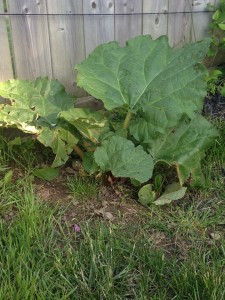10 Things I Learned from Rhubarb Plants
by Liz Jansen
Last week my sister Mary posted this picture and caption on Facebook.

“I pirated this plant about 4 years ago..it was one of about 1000 or more that my dad could make grow 3 feet high..guess I just don’t have his touch. I still enjoy having it my back yard though.”
The plant obviously has a strong survival instinct, but it desperately needs nourishment. It’s all leaf, short-stalked, pale, and bug-infested. Curiosity prompted me to consult the expert for answers. What I learned in family history and life lessons went beyond my simple question.
Dad began farming rhubarb in 1965. Initially he had little more than an acre, grown primarily for root stock for forcing it indoors. (Rhubarb is propagated by dividing the root.) It meant a winter harvest and a source of revenue. It turned out to be hard work with little financial yield so he got out of it after 2-3 years, concentrating on his outdoor cash crop. Eventually the field grew to 15 acres producing 210 tons of rhubarb, all harvested by hand. Including mine.
These attributes which make a healthy rhubarb plant also create health and vitality for us:
- Understand your lineage. The way to plant more rhubarb is to divide the roots and replant. It means the characteristics of that root will be passed on through many generations—particularly symbolic as I study my own heritage. Traits and values are passed through our energy code without us even being aware of them. They’re part of our subconscious and it’s only when we can unlock that key that we see our self, our world, and those in it more clearly.
- Practice patience. Roots are ideally two years old before they can be forced, otherwise the yield is meager. I think of times I’ve tried to get things done before I was ready or had all the information. It’s also required when allowing body and soul to heal, like now when I’m eager to get riding again.
- Be open to continuous learning. When you let rhubarb get too old, you can’t keep the grass out of it. It takes over and invites bugs, who then settle in and eat the stalks. The processor won’t take your crop, and you’ve just taken a big financial hit. This speaks to me of remaining healthy, open to new ideas, and living a vibrant, purposeful life.
- Accept force doesn’t work in the long-term. Forcing plants goes against their natural cycle and thus hard on the roots. They become limp, are not suitable for replanting, and must be discarded. Usefulness, productivity, and longevity are all greatly reduced. Enough said.
- Nurture your whole being. It’s the obvious solution for Mary’s rhubarb plant. Dad says it needs chicken manure. “You can use commercial fertilizer too but chicken manure is best.” In order to thrive, we need the right kind of nurturing unique to us. Aside from physical nutrition, it’s up to us to manage who and what we share our energy with.
- Know where home is. When dad was getting out of rhubarb, he transplanted some of it to another location on his home farm. He could never get it to grow well there consistently. Whether it didn’t like being uprooted (pun) from its clan, or subtle soil or atmospheric differences played a role was never clear. There are environments where we’ll thrive and others where we don’t do so well. Our job is to discover the best one for us.
- Expect good things can come out of bad times. Dad initially sold his field crop to a processor in Middleport, NY, who always paid in 30 days. When one year that didn’t happen, dad called, only to discover the company had gone bankrupt, leaving him in the lurch for $10,000. That was a big blow. Fortunately fate intervened and someone from the parent company took up his case. Within 4-5 days he had $5,000 with the balance arriving a few days later. He still had to look for someone else who would buy his rhubarb and found it—closer to home, and with a family business who values dad respected. They developed a friendship that stands to this day.
- Exercise compassion. After enjoying a healthy relationship with the second company for many years, dad received an emotional call from the owner, a friend, telling him he couldn’t take all his crop that year. Kelloggs, whom they sold it to, could get rhubarb cheaper from Poland. A harvested crop doesn’t fare well sitting in the field. Dad saw his income wilting before his eyes. He had only a few more loads to deliver so dad’s friend agreed to take it, even though he didn’t know where he’d market it. But dad had pity on HIM and rather than pass on the hardship, said he’d find another way to get rid of it.
- Trust. When one company went bankrupt, dad didn’t divert energy to anger or worry, although I do remember him holding the brim of his capon his hand while scratching his head, wondering how they’d make ends meet. The same thing happened when his market dried up. There were hard times, but somehow he managed.
- Know when to cut your losses. Farming is always risky business, but that was it for dad. He pulled out his rhubarb field and went on to other things. At 64.
Life lessons are all around us, often delivered from the most unusual sources—like rhubarb plants. Our task is to remain open to recognizing them, however they appear. And then responding.

A tough plant. I’d like to add #11 – Enjoy Life, a strawberry-rhubarb Pie! Thanks
Yummy!!!